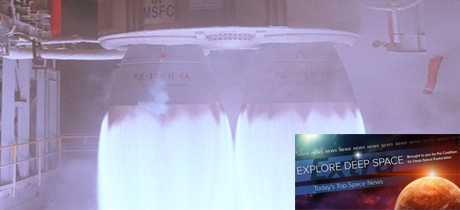In Today’s Deep Space Extra… A summer long series of Space Launch System core stage engine controller tests concluded Wednesday. The work is part of NASA plans to resume human deep space exploration.
Human Space Exploration
NASA concludes summer of testing with fifth flight controller hot fire
NASA (8/30): NASA has concluded a summer long series of five engine controller tests for the RS-25 rocket engines that will power the core stage of the Space Launch System rocket designed to start astronauts on future missions of human deep space exploration. The last of the 500 second hot fires was conducted Wednesday at NASA’s Stennis Space Center in Mississippi. The testing that began in March is part of the preparations leading up to EM-1 and EM-2, the first uncrewed and crewed test flights of the SLS and Orion crew capsule. Dates for EM-1 and EM-2 are being assessed. Four RS-25 rocket engines, whose performance is monitored by the controllers, power the core stage.
Mock astronauts complete simulated moon base mission
Space.com (8/30): In Poland, Space Garden has wrapped up a two week simulated moon base simulation for a half dozen astronaut volunteers. Two more in the series of four mission simulations that also address the challenges of exploring Mars remain.
Space Science
NASA’s InSight lander to study interior of Mars
SpaceFlightInsider.com (8/30): After a delay to deal with a vacuum leak in a European science instrument, the NASA led Mars Insight lander mission is undergoing preparations for a May 2018 launch to the Red planet. Insight is instrumented to detect and assess subsurface activities on Mars. The findings may have wider implications for the evolution of rocky planets like the Earth.
Casting light on mystery of a star that vanished after 14 days
New York Times (8/30): Michael Shara, an astrophysicist at the American Museum of Natural Science, may have solved the mystery over a star that seemed to disappear following its discovery by Korean astronomers six centuries ago.
Cassini’s ringside seat at Saturn coming to an end
Aviation Week (8/30): Two decades ago, a complex NASA led mission to Saturn called Cassini launched with the European and Italian space agencies as partners. Seven years later, the unmanned spacecraft reached its distant destination and released a lander that touched down on Saturn’s moon Titan. With the Cassini mission just weeks away from coming to a close, Titan remains a mystery, a potential habitable environment and a focus of possible future missions to learn more.
Akatsuki probe spots horrific winds over Venus’ equator
Asahi Shimbum of Japan (8/30): Japan’s Akatsuki orbiter at Venus has discovered a high velocity and high altitude wind phenomena near the planet’s equator. The findings were published in the journal Nature Geoscience.
$100 million E.T. hunt spots 15 mysterious light flashes
Space.com (8/30): Astronomers puzzle over a series of Fast Radio Bursts coming from a galaxy, FRB121102, three billion light years away. Among them is a scientist with Breakthrough Listen, the $100 million effort to look for signals from possible intelligent civilizations among the one million closest stars and 100 galaxies closest to the Milky Way.
Other News
Dynetics breaks ground on new $21 million aerospace complex
Coalition Member in the News
WHNT19 TV of Decatur, Alabama (8/29): Dynetics hosts a ground breaking ceremony for new facilities close to those of United Launch Alliance and Ruag. Dynetics specializes in the manufacture of large space structures to foster human exploration.
Companies pledge millions in Harvey donations
Coalition Members in the News
Fox business (8/28): Boeing and Lockheed Martin are some of the companies pledging donations for the Hurricane Harvey relief. Boeing has pledged 1 million dollars to the Red Cross and Lockheed Martin has pledged $380K to the Red Cross and to the Greater Houston Community Foundation.
Orbital ATK donates $100,000 for Hurricane Harvey relief
Coalition Member in the News
SpaceRef.com (8/30): Orbital ATK, Inc., a global leader in aerospace and defense technologies, announced today that the company is donating $100,000 to the United Way of Greater Houston to aid in Hurricane Harvey relief efforts in the area. The United Way of Greater Houston supports emergency response organizations like the Red Cross, Salvation Army and many others so they can act quickly in times of disaster.
It looks like yet another satellite is breaking apart at GEO
Ars Technica (8/31): The U.S. geostationary satellite tracking company ExoAnalytic Solutions has detected signs that the state owned, 18-year-old Indonesian satellite Telkom-1 has started to come apart for yet to be explained reasons. This follows the apparent breakup of AMC-9, a geostationary satellite owned by SES, of Luxembourg, in June. Satellite breakups in geostationary orbit are rare.
Sierra Nevada Corp.’s Dream Chaser space plane takes to the air for captive-carry test
Geek Wire (8/30): Sierra Nevada’s Dream Chaser took to the air while tied to a helicopter on Wednesday for a milestone captive carry test at Edwards Air Force Base, California. Sierra Nevada is under contract to NASA for the delivery of cargo to and from the International Space Station with Dream Chaser beginning in 2019.

